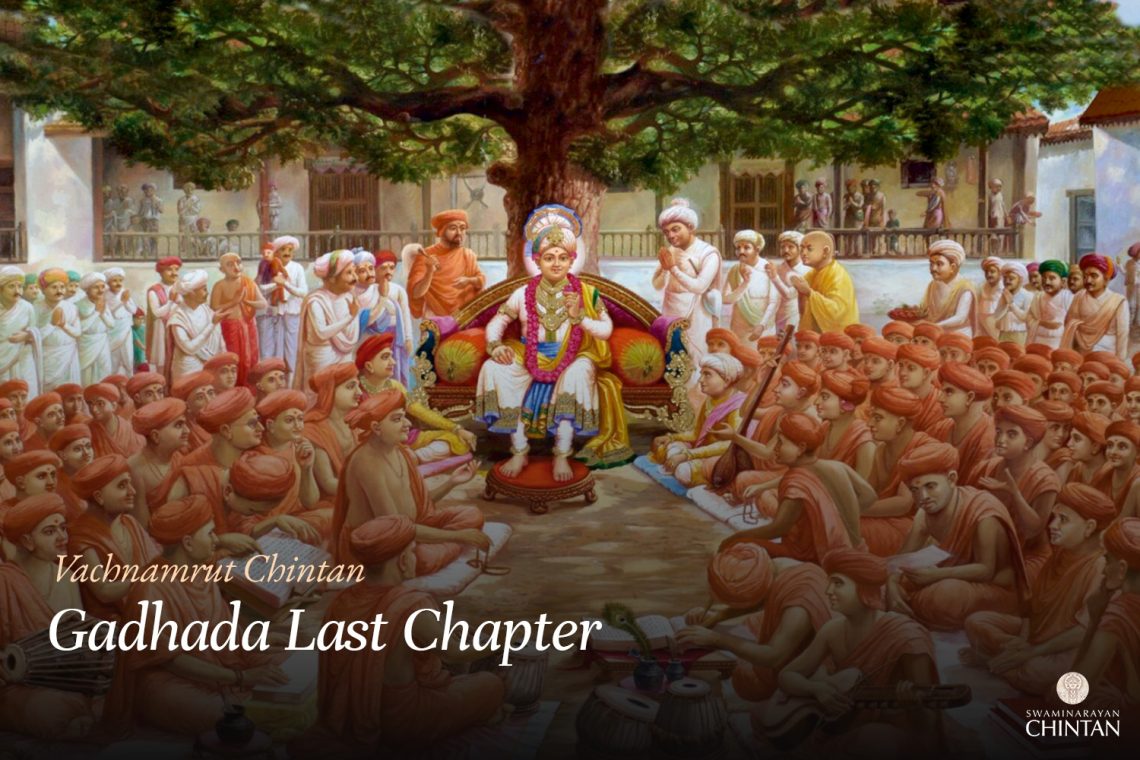Central Insights:
- The Principle from Shreeji Maharaj’s Heart.
Key Points:
- Atmabuddhi (identifying oneself with the soul) toward Bhagwan and His Sant (saint).
- Resolutely siding with Bhagwan and His devotees.
- Fixing one’s mind firmly on the form of Bhagwan.
Explanation:
In this Vachanamrut, Maharaj addresses all devotees, saying, “I will now share the principle of my heart.” He emphasizes that anyone who desires their ultimate welfare should cultivate the following four practices:
- Develop Atmabuddhi toward Bhagwan and His Sant.
- Maintain unwavering support for devotees of Bhagwan.
- Firmly focus one’s mind on the lotus feet of Bhagwan.
- Live life with the divine sentiment that even while residing in this body, one is already in the dham (divine abode) of Bhagwan.
Maharaj states that this is His principle. This Vachanamrut is metaphorically referred to as “Vajra-ni Khili” (The Nail of Diamond), signifying that these four principles should be fixed as firmly as a diamond nail.
Maharaj explains that one who seeks their welfare must recognize Bhagwan and His Sant as the only true sources of happiness in the world. This understanding develops when one regards Bhagwan and His Sant as the dearest to their heart, surpassing even attachment to the body. Typically, the greatest Atmabuddhi is in the body, as it is erroneously perceived as the source of happiness. However, to the extent that one experiences happiness from Bhagwan and His Sant, one will develop Atmabuddhi toward them.
Secondly, one must always take the side of a devotee of Bhagwan. Just as people instinctively support their body and its connections, they never find fault in them, nor do they grow weary of them. Instead, they regard them as sources of joy, protect them, and even risk their lives for them. These actions reflect the inherent allegiance toward the body. Similarly, if one holds Atmabuddhi and unwavering support for devotees of Bhagwan, even the most powerful internal enemies, such as lust and anger, cannot defeat such a person. These internal enemies, which do not relent even through strict austerities, are vanquished through Atmabuddhi and support for Bhagwan’s devotees.
When Atmabuddhi toward Bhagwan and His true Sant arises, virtues like dharma, knowledge, detachment, and devotion flourish within one’s heart. Simultaneously, negative tendencies like lust, anger, and greed are naturally eradicated. This happens because Bhagwan is the embodiment of all auspiciousness and is the singular source of ultimate welfare. Consequently, when Atmabuddhi develops toward Him, these virtues inevitably arise. This eliminates the need to struggle against one’s internal enemies; their defeat occurs effortlessly. Even without perfect Atmabuddhi, deeply revering the virtues of Bhagwan and His Sant can subdue the most powerful undesirable traits. There are ample examples of this in the satsang.
Next, Maharaj instructs that one’s mind should be firmly fixed on the lotus feet of Bhagwan, like a nail hammered into a diamond ground. Additionally, one should live with the divine sentiment that, while in this body, one is already residing in Bhagwan’s dham. The devotees and Bhagwan’s attendants, whom one expects to encounter after death, are already present here. Such divine sentiments can only arise when Atmabuddhi, affection, and loyalty are cultivated toward Bhagwan and His Sant. Without these, even the greatest mental efforts cannot evoke this sentiment, as inner shortcomings cannot be resolved through mere practice.
Shreeji Maharaj has stated in Vachanamrut Gadhada First Chapter 56: “By studying the scriptures, discerning the distinction between atma (soul) and anatma (non-soul), or by hearing such principles from a great Sant, one does not truly attain this realization. It arises only to the extent one develops unwavering faith in one’s Ishtadev (cherished deity). Without such faith, nothing can be achieved.” Hence, without Atmabuddhi, divine sentiments in the heart are unattainable.
Glossary
| Atmabuddhi – Deep Attachment with someone like the soul |
| Vajra-ni Khili – Nail of Diamond A metaphor for the unshakable principle of Atmabuddhi and loyalty toward Bhagwan and His Sant. |
| Dham – Divine abode of God |
| Dharma – Righteousness |
| Detachment – Vairagya A state of non-attachment to worldly desires, leading to inner purity and spiritual progress. |
| Internal Enemies – Lust, anger, greed, and other vices Negative tendencies within a person that obstruct spiritual growth. |
| Ishtadev – Chosen deity The personal deity or form of God that a devotee worships and meditates upon, often chosen according to individual devotion. |
| Loyalty – Unwavering allegiance Resolute support for Bhagwan and His devotees, akin to one’s natural allegiance toward their own body. |
| Divine Sentiments – Spiritual outlook |

